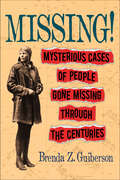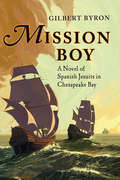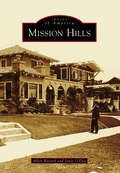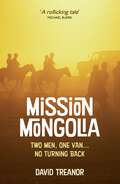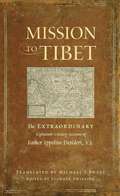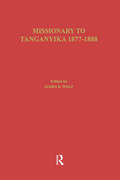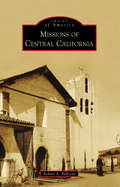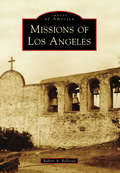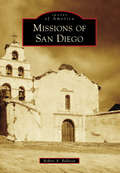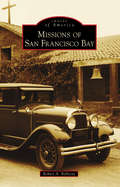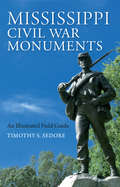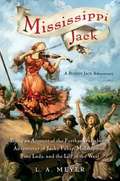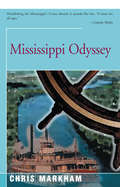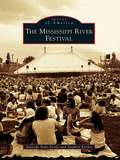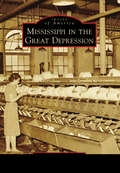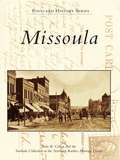- Table View
- List View
Miss-adventures: A Tale of Ignoring Life Advice While Backpacking Around South America
by Amy BakerAfter planning to backpack round South America, Amy spends the next three months fending off well-meaning but absurd advice, which she ignores… right up until she runs into trouble. Part memoir and part inspirational traveller’s tale, Miss-adventures is a funny and frank account of a young woman exercising her independence.
Miss-adventures: A Tale of Ignoring Life Advice While Backpacking Around South America
by Amy BakerAfter planning to backpack round South America, Amy spends the next three months fending off well-meaning but absurd advice, which she ignores… right up until she runs into trouble. Part memoir and part inspirational traveller’s tale, Miss-adventures is a funny and frank account of a young woman exercising her independence.
Missing 411 - Western United States and Canada: Unexplained Disappearances in North Americas That Have Never Been Solved
by David PaulidesMissing-411 is the first comprehensive book about people who have disappeared in the wilds of North America. It's understood that people routinely get lost, some want to disappear but this story is about the unusual. Nobody has ever studied the archives for similarities, traits and geographical clusters of missing people, until now. A tip from a national park ranger led to this three year, 7000+ hour investigative effort into understanding the stories behind people who have vanished. The book chronicles children, adults and the elderly who disappeared, sometimes in the presence of friends and relatives. As Search and Rescue personnel exhaust leads and places to search, relatives start to believe kidnappings and abductions have occurred. The belief by the relatives is not an isolated occurrence; it replicates itself time after time, case after case across North America. The research depicts 28 clusters of missing people across the continent, something that has never been exposed and was a shocking find to researchers. Topography does play a part into the age of the victims and certain clusters have specific age and sex consistency that is baffling. This is not a phenomenon that has been occurring in just the last few decades, clusters of missing people have been identified as far back as the 1800's. The manuscript for the research was extremely large so the story was split between two books, Missing 411 Western United States and Canada and Missing 411 Eastern United States. The Eastern version will be released in late March and will include a list of all missing people in each edition and a concluding chapter that draws both books together for conclusions. Some of the issues that are discussed in each edition:* The National Park Service attitude toward missing people* How specific factors in certain cases replicate themselves in different clusters* Exposing cases involving missing children that aren't on any national database* Unusual behavior by bloodhounds/canines involved in the search process* How storms, berries, swamps, briar patches, boulder fields and victim disabilities play a role in the disappearance* The strategies of Search and Rescue personnel need to change under specific circumstances Major news organizations do a deplorable job of coveringstories and issues which are deemed too unusualor too far outside the box. Chances are, they will find a wayto trivialize or ignore the disturbing evidence accumulatedby David Paulides, a former lawman turned investigativejournalist. The paper trail uncovered by Paulides throughsheer doggedness is impressive, the evidence indisputable. People are vanishing without a trace from our nationalparks and forests, yet government agencies are saying nothing. At a minimum, this story deserves space on the frontpage of every newspaper in the country, and it warrants aformal high level inquiry by the federal agencies whose files leave little doubt that something very strange is unfolding in our wilderness. George Knapp, Host, Coast to Coast AM-After reading this book, you will forever walk in the woods with a different awareness.
Missing 411- Eastern United States: Unexplained Disappearances of North Americans That Have Never Been Solved
by David PaulidesPeople have been disappearing under mysterious circumstances for centuries. During the last 150 years the media has covered many of these cases and has attempted to put a rational spin on a very unusual event. After 3+ years and 7000 hours of intensive research there is a new paradigm being presented on people missing in the wilds of North America. "Missing 411" identifies 28 clusters of missing people who have vanished in remote areas of the continent. The finding is a troubling fact questioning why and how these people have disappeared. Some of the victims are found and tell a very interesting and mind bending story of their experience, others are never found, a fact that confounds searchers and law enforcement. There are many children that have disappeared under highly unusual circumstances. After weeks of searching and failing to find any evidence of the child being in a remote location, many parents and law enforcement draw the conclusion that the victim was kidnapped, yes, taken by someone lurking in remote areas of our national parks, forests, farms and even ranches. There are two editions of this research, "Missing 411-Eastern United States" and "Missing 411-Western United States. " The eastern United States copy has a list of every person who is listed in each book as well as a final conclusion to the investigation. You will be shocked by the lack of interest and documentation that many of our governmental bodies have committed to missing people. After reading these books you will never look at our wildlands the same. Major news organizations do a deplorable job of covering major stories and issues which are deemed too unusual or too far outside the box. Chances are, they will find a way to trivialize or ignore the disturbing evidence accumulated by David Paulides, a former law man turned investigative journalist. The paper trail uncovered by Paulides through sheer doggedness is impressive, the evidence indisputable. People are vanishing without a trace from our national parks and forests, yet government agencies are saying nothing. At a minimum, this story deserves space on the front page of every newspaper in the country, and it warrants a formal high level inquiry by the federal agencies whose files leave little doubt that something very strange is unfolding in our wilderness. "George Knapp, Host, Coast to Coast AM
Missing!: Mysterious Cases of People Gone Missing Through the Centuries
by Brenda Z. GuibersonIn this photo-illustrated middle-grade nonfiction book, Brenda Guiberson explores the stories of six individuals who have disappeared mysteriously throughout history.Jimmy Hoffa, Barbara Follett, Amelia Earhart, D. B. Cooper, two young royal princes—they all disappeared. Throughout history, individuals have gone missing without a trace; some of these disappearances haunt us. In this companion to Disasters: Natural and Man-Made Catastrophes through the Centuries, Brenda Guiberson explores the stories of seven individuals who have disappeared mysteriously. Thoroughly researched and illustrated with photographs and line drawings, Missing!: Mysterious Cases of People Gone Missing Through the Centuries is exciting middle-grade nonfiction that also discusses the kind and qualities of evidence needed to lay these mysteries to rest.Godwin Books
Mission Boy: A Novel of Spanish Jesuits in Chesapeake Bay
by Gilbert ByronMission Boy tells a little known, true story of early American history. Nearly forty years before the English founded their first permanent colony in the New World, at Jamestown, a small group of Jesuit missionaries sailed north from Havana, Cuba to land in virtually the same location. Guided by a Native American convert to Christianity whom they called Don Luis, the Jesuits hoped to bring Christianity to the Algonquin Indians and to claim a new territory for King Phillip II of Spain. Their mission did not go according to plan. The Indian guide they depended on slipped back into the forests. Within half a year, only one of their number remained alive. And he had to wait more than another year for rescue, in a vast, beautiful, but treacherous land. In a manuscript written nearly 50 years ago, but not published until 2015, venerated Chesapeake Bay poet and novelist Gilbert Byron tells the tale of this lost and long-forgotten Jesuit mission.
Mission Hills
by Janet O'Dea Allen HazardSeveral visionaries shaped the character that defines present-day Mission Hills. First, there was Sarah Miller, stepdaughter of Captain Johnston of the SS Orizaba. She inherited land from him and built a dream home overlooking Old Town and the Pacific Ocean. There was also Kate Sessions, the mother of Balboa Park, whose nursery growing grounds just outside the original Mission Hills subdivision proved difficult for her clientele to traverse, leading her to convince transportation mogul John D. Spreckles to expand the streetcar route to accommodate her business. In 1905, George Marston, a San Diego civic leader, commissioned landscape architect and urban planner John Nolan to implement a development plan for the city. Nolan's plan, however, was never adopted. In 1908, as if to prove what was possible, Marston's syndicate formed the restricted subdivision of Mission Hills. Then, in 1909, the city announced plans to celebrate the opening of the Panama Canal. The fuse was lit, and the boom that followed brought builders and skilled artisans to San Diego. As a result, Mission Hills became architecturally magnificent.
Mission Mongolia: Two Men, One Van, No Turning Back
by David TreanorFifty-something BBC journalists Geoff and David eagerly volunteered for redundancy. But rather than easing into retirement, they decided to buy a van and drive off to Mongolia. In an epic journey from Ukraine to the Gobi Desert, they discover more about each other in a few weeks than they did sharing an office for years.
Mission Mongolia: Two Men, One Van, No Turning Back
by David TreanorFifty-something BBC journalists Geoff and David eagerly volunteered for redundancy. But rather than easing into retirement, they decided to buy a van and drive off to Mongolia. In an epic journey from Ukraine to the Gobi Desert, they discover more about each other in a few weeks than they did sharing an office for years.
Mission to Tibet
by Michael J Sweet Leonard Zwilling Fr. Ippolito Desideri S.J.Mission to Tibet recounts the fascinating eighteenth-century journey of the Jesuit priest ippolito Desideri (1684 - 1733) to the Tibetan plateau. The italian missionary was most notably the first european to learn about Buddhism directly with Tibetan schol ars and monks - and from a profound study of its primary texts. while there, Desideri was an eyewitness to some of the most tumultuous events in Tibet's history, of which he left us a vivid and dramatic account. Desideri explores key Buddhist concepts including emptiness and rebirth, together with their philosophical and ethical implications, with startling detail and sophistication. This book also includes an introduction situating the work in the context of Desideri's life and the intellectual and religious milieu of eighteenth-century Catholicism.
Missionary of Tanganyika 1877-1888
by Edward Coode HoreThis account of an evangelical initiative at Lake Tanganyika was first published in 1892. It looks at Ujiji society and commerce and includes a description and comparison of the peoples that was done for the Anthropological Institute.
Missions of Central California
by Robert A. BellezzaAfter the discovery of Alta California, the Spanish Crown charged the first Franciscan friars to enter into the New World through Lower Baja, with a succession of conquistadors, explorers, and soldiers, on a trail called El Camino Real or "The Royal Road." The settlement began in 1769 at Mission San Diego de Alcalá, a new port and military presidio with buildings of mud, brushwood, and tule grass. Fr. Junípero Serra, the legendary mission presidente and founding father of nine missions, traveled along a worn path lined today by symbolic bell markers leading to many remarkable, modern cities. After 1772, settlements were spread to California's central coast region, filling with native neophytes who became the residents and builders of all mission settlements. The Spanish missions had brought dramatic changes to California's landscape and forged the underpinnings of its earliest history, founded serendipitously with the American Revolution and birth of the United States.
Missions of Los Angeles
by Robert A. BellezzaAfter establishing the settlement of San Francisco, visionary mission president Fr. Junipero Serra journeyed south to found Mission San Juan Capistrano, Alta California's seventh, on November 1, 1776. By order of King Carlos III of Spain, El Pueblo de la Reina de los Ángeles (the Town of Our Lady the Queen of the Angels) was founded on September 4, 1781, following the recommendation of the first California governor, Felipe de Neve. At nearby Mission San Gabriel Arcángel, de Neve gathered a group of 11 men, 11 women, and 22 children, soldiers, mission priests, and a few Indians and traveled nine miles to the banks of the Los Angeles River, blessing the new site. By 1800, the city of Los Angeles had a population of 300 with a meeting hall, guardhouse, army barracks, and granary. Built a day's journey apart on El Camino Real, the Mission San Fernando Rey de España was dedicated on September 8, 1797, and completed the lineage of California's monumental landmark missions near Los Angeles.
Missions of San Diego
by Robert A. BellezzaCalifornia's first settlement began on a trail called El Camino Real, or "The Royal Road," that was traveled by missionary pathfinders, soldiers, and conquistadors on a dramatic journey into a mysterious land. Monterey was discovered in 1603, leading to the quest. Explorers Don Gaspar de Portolá and Juan Bautista de Anza, along with ambitious Franciscan missionaries, founded 21 monumental Spanish missions and several asistencias and chapels for native neophytes, travelers, and visitors to Alta California. Following the initial landing in 1769 at San Diego's seaport, Fr. Junípero Serra founded Mission San Diego de Alcalá, California's first landmark, at the original presidio site. The mission stands today exactly where it was moved, rebuilt, and completed in 1813. The native populations of California witnessed years of change from a sleepy province to the status of US statehood. The Spanish missions forged the powerful underpinnings of the Golden State's earliest settlements 80 years prior to the world's largest migration to California, the 1849 Gold Rush.
Missions of San Francisco Bay
by Robert A. BellezzaLegendary explorer Lt. Col. Juan Bautista de Anza completed a 1,000-mile journey from Sonora, Mexico, crossing the Mojave Desert with the first settlers, to San Francisco's pristine harbor. Fr. Francisco Palóu celebrated the dedication of Mission San Francisco de Asís on June 29, 1776. First established to protect Spain's interests in Alta California from foreign ships, California's landmark buildings are featured here with newly discovered photography depicting a romantic era of colorful Spanish conquistadors, Franciscan padres, and mission Indian neophytes from 1769 to 1823. Explore the heritage of California pioneers' first communities and the 21 California Spanish missions of adobe, stone, and tile that are considered architectural wonders that have captured the imagination of visitors and historians over centuries.
Mississippi Civil War Monuments: An Illustrated Field Guide
by Timothy S. Sedore“From Vicksburg to Oxford, readers will find a rich examination of how and why Confederate and Union monuments sprang up across the state.” —Caroline E. Janney, Director, John L. Nau III Center for Civil War History, University of VirginiaSoaring obelisks, graceful arches, and soldiers standing tall atop pedestals recall the memory of the Civil War in Mississippi, a former Confederate state that boasts more Civil War monuments than any other.In Mississippi Civil War Monuments: An Illustrated Field Guide, Timothy S. Sedore combs through the Mississippi landscape, exploring monuments commemorating important military figures and battles and remembering common soldiers, from rugged veterans to mournful youths. Sedore’s insightful commentary captures a character portrait of Mississippi, a state that was ensnared between Northern and Southern ideologies and that paid a high price for seceding from the Union. Sedore’s close examinations of these monuments broadens the narrative of Mississippi’s heritage and helps illuminate the impacts of the Civil War.With intriguing details and vivid descriptions, Mississippi Civil War Monuments offers a comprehensive guide to the monuments that make up Mississippi’s physical and historical landscape.
Mississippi Civil War Monuments: An Illustrated Field Guide
by Timothy S. Sedore“From Vicksburg to Oxford, readers will find a rich examination of how and why Confederate and Union monuments sprang up across the state.” —Caroline E. Janney, Director, John L. Nau III Center for Civil War History, University of VirginiaSoaring obelisks, graceful arches, and soldiers standing tall atop pedestals recall the memory of the Civil War in Mississippi, a former Confederate state that boasts more Civil War monuments than any other.In Mississippi Civil War Monuments: An Illustrated Field Guide, Timothy S. Sedore combs through the Mississippi landscape, exploring monuments commemorating important military figures and battles and remembering common soldiers, from rugged veterans to mournful youths. Sedore’s insightful commentary captures a character portrait of Mississippi, a state that was ensnared between Northern and Southern ideologies and that paid a high price for seceding from the Union. Sedore’s close examinations of these monuments broadens the narrative of Mississippi’s heritage and helps illuminate the impacts of the Civil War.With intriguing details and vivid descriptions, Mississippi Civil War Monuments offers a comprehensive guide to the monuments that make up Mississippi’s physical and historical landscape.
Mississippi Jack: Being an Account of the Further Waterborne Adventures of Jacky Faber, Midshipman, Fine Lady, and the Lily of the West (Bloody Jack #5)
by L. A. MeyerThe intrepid Jacky Faber, having once again eluded British authorities, heads west, hoping that no one will recognize her in the wilds of America. There she tricks the tall-tale hero Mike Fink out of his flatboat, equips it as a floating casino-showboat, and heads south to New Orleans, battling murderous bandits, British soldiers, and other scoundrels along the way. Will Jacky's carelessness and impulsive actions ultimately cause her beloved Jaimy to be left in her wake? Bold, daring, and downright fun, Jacky Faber proves once again that with resilience and can-do spirit, she can wiggle out of any scrape . . . well, almost.
Mississippi Odyssey
by Chris MarkhamSince his teens, Chris Markham's hitchhiking thumb has carried him into adventures across America. His first book, Mississippi Odyssey, is a journal of his experiences hitchhiking boat rides down the Mississippi River.
Mississippi River Festival, The
by Stephen Kerber Amanda Bahr-EvolaIn 1969, Southern Illinois University Edwardsville initiated a remarkable performing arts series called the Mississippi River Festival. Over 12 summer seasons, between 1969 and 1980, the festival presented 353 events showcasing performers in a variety of musical genres, including classical, chamber, vocal, ragtime, blues, folk, bluegrass, barbershop, country, and rock, as well as dance and theater. During those years, more than one million visitors flocked to the spacious Gyo Obata-designed campus in the countryside near St. Louis. The Mississippi River Festival began as a partnership promoting regional cooperation in the realm of the performing arts. Southern Illinois University Edwardsville invited the St. Louis Symphony to establish residence on campus and to offer a summer season. To host the symphony, the university created an outdoor concert venue within a natural amphitheater by installing a large circus tent, a stage and acoustic shell, and a sophisticated sound system. To appeal to the widest possible audience, the university included contemporary popular musicians in the series. The audacity of the undertaking, the charm of the venue, the popularity of the artists, the excellence of the performances, and the nostalgic memory of warm summer evenings have combined to endow the festival with legendary status among those who attended.
Mississippi Solo: A River Quest
by Eddy Harris Eddy L. HarrisSince the publication of his first book, Mississippi Solo, Eddy L. Harris has been praised for his travel writing. In this exciting reissue of his classic travelogue, readers will come to treasure the rich insightful prose that is as textured as the Mississippi River itself. They will be taken by the hand by an adventurer whose lifelong dream is to canoe the length of this mighty river, from Minnesota to New Orleans. The trip's dangers were legion for a Black man traveling alone, paddling from "where there ain't no black folks to where they still don't like us much." Barge waives loom large, wild dogs roam the wooded shores, and, in the Arkansas dusk, two shotgun-toting bigots nearly bring the author's dream to a bloody . Sustaining him through the hard weeks of paddling were the hundreds of people who reached out to share a small piece of his challenge. Mississippi Solo is a big, rollicking, brilliant book, a wonderful piece of American adventure, and an unforgettable story of a man testing his own limits.
Mississippi Solo: John Murray Journeys (Overcoming Books)
by Eddy L HarrisINTRODUCED BY ADAM WEYMOUTH, award-winning author of The Kings of Yukon'A wonderful book -- and a highly original contribution to the literature of travel' PAUL THEROUX'The Mississippi. Mighty, muddy, dangerous, rebellious and yet a strong, fathering kind of river. The river captured my imagination when I was young and has never let go.' Mississippi Solo tells the story of one man's voyage by canoe down the Mississippi River from its source in Minnesota to the Gulf of Mexico - a longtime dream, and a journey of over 2,000 miles through the heart of America. Paddling into the Southern states - going from 'where there ain't no black folks to where they still don't like us much' - Eddy is confronted by the legacy of slavery and modern racism, including an incident with a pair of shotgun-toting bigots. There are also the dangers of passing barges, wild dogs roaming the wooded shore, and navigating a waterway that grows vaster, and more hazardous, every day. But Eddy also encounters immense human kindness, friendship and hospitality, as well as coming to know the majestic power - and the awesome dangers - of the river itself. Mississippi Solo is an unforgettable American adventure.
Mississippi in the Great Depression (Images of America)
by Richelle PutnamBy the time the Great Depression was well underway, Mississippi was still dealing with the lingering effects of the flood of 1927 and the Mississippi Valley drought of 1930. As Pres. Franklin Roosevelt took office in 1933, Mississippi senator Pat Harrison, chair of the Senate Committee on Finance, oversaw the passage of major New Deal legislation, from which Mississippi reaped many benefits. Other Mississippi politicians like Gov. Mike Connor initiated measures to improve the treatment of inmates at Parchman Prison in the Delta and Gov. Hugh White established the Balancing Agriculture with Industry initiative. Women also played an active role. The Natchez Garden Club successfully spurred tourism by starting the state's first pilgrimage in 1932. Mississippians found employment through the Public Works Administration and the Civilian Conservation Corps, which stimulated economic development through new and add-on construction in urban and rural areas and the construction of nine state parks. For black Mississippians, segregation and discrimination in New Deal benefits and jobs continued, but what they did receive from the federal government spurred a determination to fight for equality in the Jim Crow South.
Mississippi! (Wagons West Series, Book #15)
by Dana Fuller RossFrom north of St. Louis down past Natc Kez to the fertile Bayou, the broad deep river carried barges piled high with valuable cargo and stern -wheelers crowded with eager Americans hungry for the sin and sweetness of exciting New Orleans, But on its seamier streets a dark underworld flourished. There, a cruel ex-lawman hid the beautiful young gentlewoman he had seduced with lies, while he plotted to kill the bold Englishman who had sworn to avenge her honor. And from the far west rode Toby Holt-a fighting man as famous as his father, Wagonmaster Whip Holt-to wage a one- man war on a dreaded Oriental Tong... as the forces of good and evil prepared to battle for control of this rich, fast growing land along the MISSISSIPPI!
Missoula
by Svoboda Collection at the Northern Rockies Heritage Center Stan B. CohenMissoula began in 1860 as Hellgate Village, a trading post located about 4 miles west of what is now downtown. In 1864, the construction of a mill powered by water diverted from Rattlesnake Creek drew residents of Hellgate to the new town, and the arrival of the Northern Pacific Railroad in 1883 assured Missoula's future. The establishment of the University of Montana led to growth on the south side of the Clark Fork River, and the timber industry drove the economy. Missoula has evolved into a trade, medical, educational, and governmental center of western Montana.



